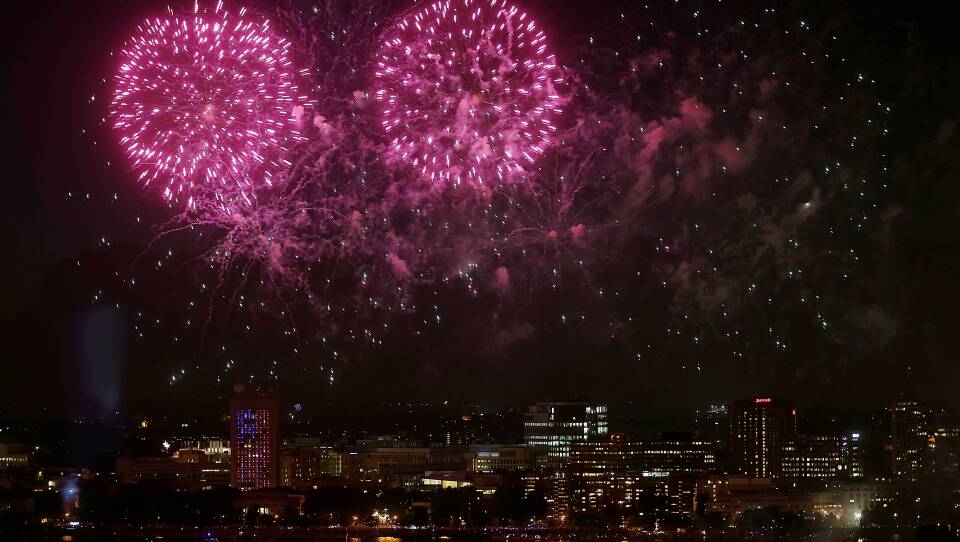From North Adams to Provincetown, scores of Massachusetts towns will celebrate this year's Fourth of July with a fireworks display. It’s a time-honored, American tradition, and I've long wondered exactly how the folks who put these extravaganzas on pull them off.
Of course, my quest to understand the science and art behind a fireworks show quickly led me to New Hampshire — back into the woods on a dirt road in Kingston, to the storage space for American Thunder Fireworks.
"We're a Massachusetts corporation," said company president Warren Pearce, explaining that their storage facility is in New Hampshire since they need a fair amount of land far away from civilization.
Stored here is everything from tools to electrical equipment. As for how many fireworks they have on site?
"We’ve got 150,000 shells or something," said Pearce. "That’s not really a lot. They go away quick."
What you or I might call fireworks, Pearce calls shells. And, really, that’s what they are. They’re round-ish, wrapped in brown paper, and range in size from 2.5 inches — about the size of a tangerine — to 12 inches, which is larger than a basketball.
All of Pearce's shells — and the vast majority of shells that will burst in the skies over American towns large and small this Independence Day — are made in China. And it's worth noting that fireworks have thus far avoided any tariffs in the ongoing U.S.-China trade war.
These shells come in an astounding array of colors and shapes, many of them named after flowers that they resemble as they perform in the sky.
"We’ve got chrysanthemums, we have peonies, dahlias, cycas blooms," said Pearce, ticking off some of the shells commonly used in American Thunder Firework's shows.

As for what makes each of these shells do its specific thing? That’s the science part. Think of them as mini-multi-stage rockets. Stage one gets the shell up in the air. A fuse sticks out of each one. When lit, it ignites a black powder inside known as the "lift charge," and sends the whole shell skyward.
"And it also lights the time fuses," said Pearce.
The time fuses are designed to burn for a precise interval so that stage two — called the burst charge — gets lit at the peak of the shell’s flight. The burst charge, in turn, ignites what are called stars, and blasts them streaking through the sky. Essentially, the stars are the firework — chemical compounds made to burn a certain way, for a certain length of time, at a certain color. How those stars are packed and contained inside the shell determines the shape of the effect.
Each shell is fired into the air from tubes. In the old days, a whole show might be done with just a few tubes buried in the ground — each one loaded, cleaned and reloaded in real time by a team of technicians.
"I did a couple of reloading shows many years ago and decided that really wasn't my cup of tea," said Pearce. "The thought of carrying a live shell while another one is going off into the air in flames? That really didn't work too well for me."
Today, nearly all shows are pre-loaded, with hundreds, if not thousands, of shells selected and placed individually in tubes before the start. Remarkably, in a lot of places, the shell are still ignited one at a time, by hand.
"There are some people in this business who won’t do it any other way," said Pearce.
But in Massachusetts, all fireworks shows are required to be fired electronically. That means every shell is wired into some sort of system. It might be analogue, where the shooter flips switches on a panel to send individual shells, or groups of shells, into the skies. Or it could be fully digital — with the whole show designed in a software program and fired from a laptop or tablet.
As for determining which shells fires when? Well, that’s where the art comes in.
"There’s a lot that goes into it," said Rob Jacobs, co-owner of JPI Pyrotechnics in New Hampshire. "Everybody has a slightly different technique, but there is a basis for what we’re doing."

He says a 30-minute pyromusical — a show where the fireworks display is synchronized with specific music — can easily take 40 hours to design, even with the help of sophisticated software.
"It’s like looking at a music score on sheet music, almost," he said of the program many fireworks designers use. "[The score] will scroll past you as the music’s playing, and you drop your effects in."
But even your standard municipal show takes hours of forethought and planning.
You have to scout your space...
"Location is everything," said Jacobs. "It governs what size and what types of shells you can fire, what effects you can use."
Work out an appropriate color scheme for the occasion...
"Obviously Fourth of July, we use a lot of reds, whites and blues," said Jacobs.
And then — essentially — you tell a story. Jacobs says you have to vary the color, shapes, height in the sky, speed with which you are firing, and combinations.
"[There are] single shell shots, double shells, salutes — which are those shells that just go up and go boom —things we call flights, which are two, three, or five shells that go up at once," he explained.
And it all has to flow in a way that holds interest, yet still builds to the always-anticipated finale.
"And then the show is done," said Jacobs, "Usually, it's capped off with a very large shell or a large salute, which says goodnight."
And if you find yourself taking in a fireworks display in your town this Fourth of July, before you say goodnight, you might want to take a moment to think about the hours of effort it took to make 20 minutes of magic in the sky.





